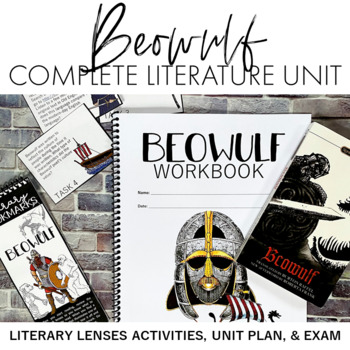Beowulf Workbook + Complete Literature Unit (Activities, Unit Plan, and Exam)
- Zip
What educators are saying
Description
Engage your students in a critical analysis of Beowulf! This unit uses a scaffolded approach uses literary lenses, so students can start with a foundation and build to higher-order thinking activities. They will begin with Beowulf Literary Bookmarks, a study guide, and reader response quick write prompts to focus their reading and comprehension and personal connection to the story. Then, they will work to higher-order thinking skills with analysis activities that teach students about literary concepts, such as archetypes, epic characteristics, conflicts, and epic heroes. Finally, students will create an alternative interpretation of Beowulf by deconstructing the monster Grendel.
An editable quiz and text-based multiple choice practice are included. This unit is accessible for all levels, and especially great for AP English students. It is optimized for digital use as well as print use!
CONTEXTUAL VOCABULARY STUDY
The unit includes five contextual vocabulary words with a Q & A section to empower students to connect the meanings of these words to new contexts. Not only does the Q & A provide a great means for discussion, it also helps students go beyond memorizing definitions. They will be challenged to learn the word as a concept and apply the word to different contexts in both the Q & A practice and the exam. I also included a blank vocabulary page so you can use this with your own word list if you’d like.
GUIDED READING
Students can use Beowulf Literary Bookmarks for focused reading. I also included editable guided reading questions. These questions are based on the translation in our textbook by Burton Raffel. They can be left out or used partially if your textbook or version only includes some selections from Beowulf. The pages are divided by sections: 1) The Monster Grendel, 2) Unferth’s Challenge, 3) The Battle with Grendel and The Monster’s Mother, and 4) The Final Battle. These guides can be given as a group or distributed individually for each section. They are designed to supplement reading for formative assessment to check for comprehension.
EXAM
An editable quiz is included as both a Word Document and a Google Form. It includes 10 critical reading questions fully aligned with the analyses in the unit, 5 context-based vocabulary multiple choice questions, 5 text-based questions on a passage, and one open-ended question aligned with the critical analysis study. An answer key and explanations for each question are included.
SUGGESTED ANSWER KEY
The unit includes suggested answers or example answers for each question, prompt, or task in the unit when applicable.
UNIT GUIDE
An example unit guide is included to help you with scope and sequence while planning your unit. It is based on a 45-minute period. Please note that this is just a guide, and it should be adapted to best suit your class and your objectives. On the guide, you will find detailed notes for setting up, organizing, planning, and teaching your unit.
**Check out the preview!**




